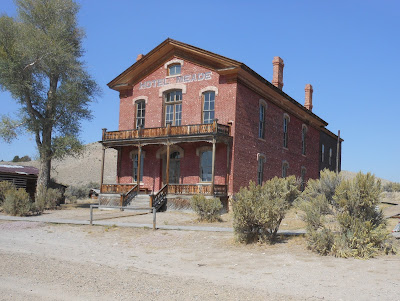For many years, Idaho license plates have included the phrase “Famous
Potatoes”. Spuds are the state’s No. 1 agricultural crop
and Idaho grows more than any other state.
The town of Blackfoot claims to be the “Potato Capital of the
World”. More than 20 million 100-pound
sacks of spuds are harvested in the Blackfoot area every year. That’s a good thing since the average
American gobbles down 139 pounds of baked, fried, scalloped and mashed potatoes
every year.
We couldn’t pass Blackfoot without stopping at the Potato
Museum. This unusual museum occupies
a restored 1912 stone depot building. In
front of the building sits the world’s largest potato. It’s not a real spud and it’s not pretty, but
they claim it’s the largest so we’ll go along with that.
 The history of the potato is showcased here in all its
glory. Luther Burbank is given credit
for developing the Russet Burbank potato, which is the most popular variety.
The history of the potato is showcased here in all its
glory. Luther Burbank is given credit
for developing the Russet Burbank potato, which is the most popular variety.
Photographs and displays led us through the fascinating
revolution of the potato industry. We
learned about the original potato planted in Idaho and saw, with our very own
eyes, the “World’s Largest Potato Chip”, made by the Pringle’s Company.
 |
| Potato Masher Collection |
We were impressed by the museum’s awesome display of 100 or more
potato mashers, an assortment of planting, cultivating and sorting machinery,
and an impressive collection of Mr. Potato Heads. Remember them?
As we departed through the gift shop, Bonnie purchased a book of potato recipes and we were blessed with a complimentary 4-serving box of dehydrated hash browns. You can't imagine how thrilled we were.
As we departed through the gift shop, Bonnie purchased a book of potato recipes and we were blessed with a complimentary 4-serving box of dehydrated hash browns. You can't imagine how thrilled we were.
We continue to notice that every town is unique. Each has interesting stories, famous persons
or historic sites. The Blackfoot Potato
Museum displays a quality product that Idaho proudly produces in great
quantities.
But potato pride is not
limited to the museum. The Shelley High
School “mascot” is the potato, a “russet” to be exact. "Go Russets!" And, the Idaho Falls professional baseball
team was the “Russets” for many years, before changing their name to the
Chukars.
We spent a few days in Pocatello, home of Idaho State University and the Museum of Clean. In case you haven't heard of it, it's a new museum that traces the history of cleaning tools, products and techniques. It was on our hit list but, unfortunately for us, it was closed on Sunday. We'll catch it next time for sure.
Most of Pocatello's newer commercial growth has occurred along its very long strip commercial corridor. Progress left behind a very nice old "historic" business district. We spent part of a day in that district looking at the old brick architecture, wandering through the farmers market and attending an open house of the local model railroad club. They had train layouts in all scales as well as photographs and other historic displays.
 |
| HO scale model railroad layout |
On September 17, we drove across southern Idaho and spent a very noisy night in Caldwell, listening to freeway noise and trains all night. On the positive side, the RV park had an attractive fishing lake and trails along the Boise River. The next day we continued into Oregon, one of two states that don't allow us to fill our own gas tank. Other than that minor irritant, we love Oregon and are looking forward to a good time there.
 |
| The lake at Caldwell RV Park |
 |
| Boise River |



















































